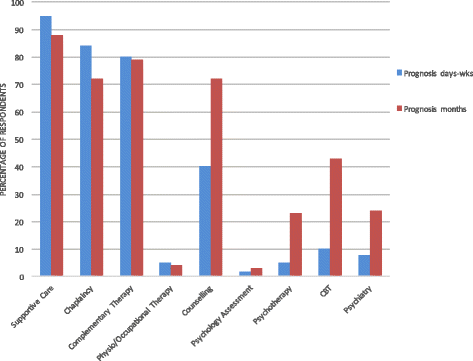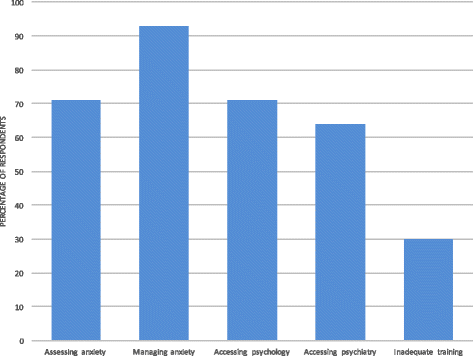'Worried to death': the assessment and management of anxiety in patients with advanced life-limiting disease, a national survey of palliative medicine physicians
- PMID: 29224571
- PMCID: PMC5724241
- DOI: 10.1186/s12904-017-0245-5
'Worried to death': the assessment and management of anxiety in patients with advanced life-limiting disease, a national survey of palliative medicine physicians
Abstract
Background: Anxiety adversely affects quality of life and is common in adults with advanced life-limiting disease. There are no UK-wide guidelines on the assessment and management of anxiety in this specific population and there is little evidence regarding drug treatments. This study aimed to explore how palliative care physicians assess and manage anxiety in their patients, and to identify barriers encountered.
Methods: A cross-sectional survey was undertaken of all physicians working in specialist palliative care in the UK who were members of the Association for Palliative Medicine. This was conducted in February 2014 using an online questionnaire.
Results: The response rate was 23% (230/980) and 61% of respondents were consultants. Most did not use tools to screen for anxiety (87%) and almost all used the clinical interview to diagnose anxiety (99%). Only 8% used psychiatric criteria. Most physicians reported difficulties managing anxiety (93%). Only 33% thought they had adequate training in this area. Most had difficulty accessing psychological and/or psychiatric services (71%, 64% respectively). The majority used a combination of pharmacological and non-pharmacological treatments for anxiety. The most frequently prescribed first-line medications for patients with a prognosis of days to weeks were benzodiazepines (93%), usually lorazepam. The use of benzodiazepines over antidepressants was statistically significant (p < 0.001). For patients with a prognosis of months, antidepressants were most frequently prescribed first-line (60%), significantly more than benzodiazepines (p < 0.001). However, benzodiazepine use was still common in this prognostic group with 47% prescribing it first-line, sometimes in combination with an antidepressant.
Conclusion: This is the first national survey on the assessment and management of anxiety in palliative care. Findings demonstrate the infrequent use of screening tools, variation in prescribing practice, potentially inappropriate use of benzodiazepines for patients with a prognosis of months, training gaps and poor access to psychological and psychiatric services in the UK. This highlights the need for formal training, further research into the pharmacological management of anxiety in this population and evidence-based national guidance to support clinical decision-making and service development.
Keywords: Anxiety; Health care surveys; Palliative care; Physicians.
Conflict of interest statement
Ethics approval and consent to participate
Ethical approval was not required for this study, as confirmed by the Joint Research Office, UCL, UK. Informed consent was obtained from all participants as part of the online survey.
Consent for publication
Not applicable
Competing interests
BC is an Associate Editor for BMC Palliative Care. The other authors declare that they have no competing interests.
Publisher’s Note
Springer Nature remains neutral with regard to jurisdictional claims in published maps and institutional affiliations.
Figures
Similar articles
-
Florida Controlled Substance Prescribing.2022 Oct 26. In: StatPearls [Internet]. Treasure Island (FL): StatPearls Publishing; 2025 Jan–. 2022 Oct 26. In: StatPearls [Internet]. Treasure Island (FL): StatPearls Publishing; 2025 Jan–. PMID: 33428370 Free Books & Documents.
-
NP Safe Prescribing of Controlled Substances While Avoiding Drug Diversion.2023 Jan 29. In: StatPearls [Internet]. Treasure Island (FL): StatPearls Publishing; 2025 Jan–. 2023 Jan 29. In: StatPearls [Internet]. Treasure Island (FL): StatPearls Publishing; 2025 Jan–. PMID: 33232099 Free Books & Documents.
-
Benzodiazepines for cancer dyspnoea: a nationwide survey of palliative care physicians.BMJ Support Palliat Care. 2020 Jun;10(2):205-208. doi: 10.1136/bmjspcare-2019-001997. Epub 2019 Dec 9. BMJ Support Palliat Care. 2020. PMID: 31818847
-
Evidence Brief: The Quality of Care Provided by Advanced Practice Nurses [Internet].Washington (DC): Department of Veterans Affairs (US); 2014 Sep. Washington (DC): Department of Veterans Affairs (US); 2014 Sep. PMID: 27606392 Free Books & Documents. Review.
-
Sustainable access to appropriate opioids for palliative care patients in Australia-preventing the need for crisis management.J Pain Palliat Care Pharmacother. 2020 Mar;34(1):13-21. doi: 10.1080/15360288.2019.1650869. Epub 2019 Dec 11. J Pain Palliat Care Pharmacother. 2020. PMID: 31825713 Review.
Cited by
-
Conceptualising effective symptom management in palliative care: a novel model derived from qualitative data.BMC Palliat Care. 2022 Feb 4;21(1):17. doi: 10.1186/s12904-022-00904-9. BMC Palliat Care. 2022. PMID: 35115005 Free PMC article.
-
Correlation of death anxiety with coping strategies among Palestinian women with breast cancer: a cross-sectional study.Front Public Health. 2024 Jun 10;12:1420306. doi: 10.3389/fpubh.2024.1420306. eCollection 2024. Front Public Health. 2024. PMID: 38915747 Free PMC article.
-
Mental Health Service Integration in Hospice Organizations: A National Survey of Hospice Clinicians and Medical Leadership.Am J Hosp Palliat Care. 2025 Jul;42(7):665-671. doi: 10.1177/10499091241233677. Epub 2024 Feb 20. Am J Hosp Palliat Care. 2025. PMID: 38378452
-
The Level of COVID-19 Anxiety among Oncology Patients in Poland.Int J Environ Res Public Health. 2022 Sep 10;19(18):11418. doi: 10.3390/ijerph191811418. Int J Environ Res Public Health. 2022. PMID: 36141692 Free PMC article.
-
End-of-Life Care in Patients with Cancer 16-24 Years of Age.Curr Oncol Rep. 2022 Feb;24(2):195-202. doi: 10.1007/s11912-021-01173-0. Epub 2022 Jan 25. Curr Oncol Rep. 2022. PMID: 35076885 Free PMC article. Review.
References
-
- Mitchell AJ, Chan M, Bhatti H, Halton M, Grassi L, Johansen C, et al. Prevalence of depression, anxiety, and adjustment disorder in oncological, haematological, and palliative-care settings: a meta-analysis of 94 interview-based studies. Lancet Oncol. 2011;12:160–174. doi: 10.1016/S1470-2045(11)70002-X. - DOI - PubMed
MeSH terms
Grants and funding
LinkOut - more resources
Full Text Sources
Other Literature Sources
Medical



